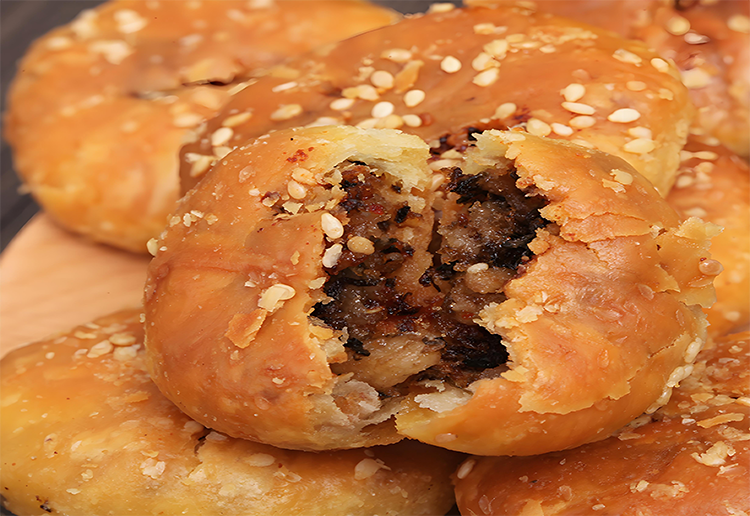Jinhua Crisp Pastry: A Millennium of Flavor
Introduction
If you visit Jinhua in Zhejiang Province and can only try one local snack, make it the famed Jinhua Crisp Pastry. Small and golden, its multi-layered crust shatters with a satisfying crunch while the filling delivers a savory, aromatic blend of preserved meigan cai (snow mustard greens) and pork. Once tasted, it lingers in memory. More than a snack, this pastry is a living culinary relic carrying local culture and craftsmanship. Perfect as a travel bite or a carefully wrapped souvenir, are you ready to bite into a thousand years of flavor?
1. Origins: From a Legendary Accident in the Tang Dynasty to a Regional Classic
The pastry’s origin reads like a folk tale. Its history traces back to the Tang dynasty, and legend credits its accidental invention to the colorful figure Cheng Yaojin. While selling flatbreads in Jinhua, he reportedly left a dough by the oven; the overbaked crust became unusually crisp. Sensing potential, he popularized this unexpected “failure.” Generations of pastry chefs refined the recipe—filling, dough, and baking technique—until the snack became the celebrated Jinhua Crisp Pastry known today.
2. Cultural Significance: More Than Food—A Taste of Home and Pride
In Jinhua the pastry is woven into daily life and rituals. For locals far from home, one bite evokes nostalgia; the scent of meigan cai recalls family tables. It’s a customary gift symbolizing goodwill and blessing—present at festivals, weddings, and celebrations as a sign of reunion and joy. The pastry now stands as a culinary landmark of Jinhua, offering visitors an accessible way to experience local culture and history.

3. Ingredients and Flavor: Simple Components, Complex Taste
The pastry’s appeal comes from modest yet perfectly paired ingredients.
- Core filling: The soul is meigan cai—salted, aged snow mustard greens—whose deep savory aroma pairs with locally sourced pork (usually with balanced fat) that releases savory juices during baking.
- Dough technique: Bakers alternate a water-oil dough with an oily laminated dough, repeatedly folding and rolling to create dozens of flaky layers—the key to that irresistible crisp.
- Final taste: Fresh from the oven the pastry is golden, crackling audibly as you bite. The warm filling bursts with umami: the meigan cai’s aged saltiness, pork’s richness, and a hint of sweetness combine into a balanced, non-greasy finish. Beyond the classic savory, modern variations include sweet and spicy versions to suit diverse tastes.
4. Craftsmanship: Dough, Filling, and the Art of Heat
A perfect Jinhua Crisp Pastry relies on meticulous handcrafting:
- Dough and lamination: Prepare a water-oil dough and an oily dough separately. Encase the oily dough in the water-oil dough, then roll, fold, and repeat to form many crispy layers.
- Filling and shaping: Soak and finely chop meigan cai, mix with diced pork, sugar, and salt. Roll out pastry rounds, fill generously, seal into flat rounds, brush with syrup or egg wash, and sprinkle sesame.
- Baking: Traditionally the rounds are stuck to the inner wall of a charcoal-fired clay oven; nowadays electric ovens are common. Bakers must control low, even heat so the pastry puffs and browns without burning—the moment it puffs golden is the master’s final test.

5. How to Enjoy: Best Moments and Pairings
Timing matters. The ideal moment is right out of the oven—hot and at peak crispness. Because the crust flakes, use a small plate or your hands to catch crumbs. A cup of clear tea—Longjing or a local green tea—cuts the richness and balances flavors.
Pairing ideas: As breakfast with plain congee, as an afternoon treat with coffee or milk tea, or as a portable travel snack—nutritious, filling, and convenient.
6. Visitor Tips: Where to Buy and What to Choose
For visitors to Jinhua:
- Where to buy: Visit established shops such as Huang Jia Chunlian, Moxiang, and Da Mazi—these brands have multiple outlets and often bake on-site.
- Choosing tips: Pick pastries that are evenly golden, plump, and sprinkled with sesame. If you can, buy freshly baked ones; for packaged boxes, check the production date.
- Bringing home: The pastry travels well and makes an excellent souvenir. Gift boxes are attractively packaged; shelf life is typically one to two months, though best eaten sooner for optimal crispness.

7. Home-Friendly Version: Recreate the Taste Simply
If you can’t resist making them at home, try a simplified method:
- Ingredients: All-purpose flour, lard or cooking oil, meigan cai, ground pork, sugar, sesame.
- Filling: Rehydrate and rinse meigan cai, chop finely, mix with pork, sugar, and a pinch of salt.
- Dough shortcut: Use store-bought laminated pastry (like paratha or hand-grabbed flatbread dough) to mimic layers.
- Assemble and bake: Wrap filling in thin dough rounds, seal and flatten, brush with egg wash or syrup, sprinkle sesame, and bake at 180°C (350°F) for 20–25 minutes until golden.
This won’t fully replicate the old-oven aroma, but it satisfies cravings and offers hands-on fun.
8. Final Word: An Unmissable Jinhua Taste
Jinhua Crisp Pastry is more than a snack: it’s history, memory, and craft in a compact, flaky bite. Made from humble ingredients yet elevated by skilled hands and time-honored technique, it offers a richly layered gustatory greeting from the city. When in Jinhua, follow the scent to an old shop, bite into that crunchy “crack,” and let the meigan cai’s savory echo complete your visit with a delicious, memorable finale.


